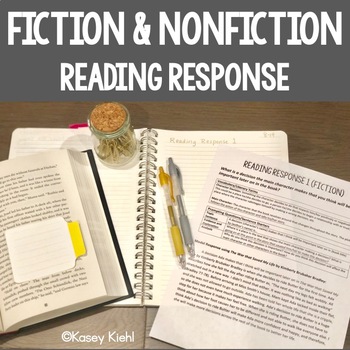Fiction & Nonfiction Reading Response (6-8)
- Zip
- Google Apps™

What educators are saying
Description
What is the purpose of this resource?
Thinking critically about reading and articulating thoughts through writing is something students should be doing frequently. Reading response for English Language Arts teachers is like double dipping because students are sharing their thinking about reading through written words. It is an authentic snapshot of where students are at in their comprehension of a fiction or nonfiction text. It also gives students a chance to write without the pressure of writing a full essay or coming up with an idea for a creative writing piece. Reading response is an “on-demand” style of writing where students have the opportunity to complete their writing about reading in a single-sitting without taking a piece through the entire writing process over the course of a week or longer. Because of all the benefits of using reading response, this resource is designed so that you can successfully implement a writing about reading system that you can stick with the entire school year.
What is included in this resource?
· 36 reading response prompts, one for every week of the school year.
· 27 reading response prompts are fiction-focused, 9 reading response prompts are nonfiction-focused.
· Every reading response prompt is aligned to a specific Common Core State Standard for Reading Literature or Reading Informational Text.
· Every reading response prompt includes a model reading response, prompting questions, sentence starters, and literary terms/vocabulary needed in order to answer the specific prompt. The intent of these supports is to provide all students with the confidence and resources they need in order to write a quality reading response.
· Every model reading response is written in response to popular middle school fiction and nonfiction books.
· Student Reading Response Checklist so students are able to self-revise and self-edit their reading response.
· Reading Response Rubric to evaluate reading standards and writing standards. Several reading response rubric choices are included (Standards-Aligned, Student Self-Evaluation, Feedback Only)
· Reading Response Graphic Organizer to use for planning reading responses prior to drafting.
· Master list of reading response prompts so teachers and/or students can track the prompts they have used across the school year.
· Explanation of TEA (Topic Sentence, Evidence & Explanation, Analysis) method
· Resource sheets on how to cite textual evidence correctly and transition words and phrases to use in reading response
What is the teacher’s role in implementing this year-long reading response system?
· At the beginning of the school year, the teacher introduces the TEA method all students will use for reading response structure.
· Model one reading response weekly using the model response included with each reading prompt.
· Go over the supports included with each reading response (prompting questions, sentence starters, literary terms/vocabulary needed).
· Assess and give feedback to students’ weekly reading responses. Feedback could also be given through conferring with students about their reading responses.
What are the different ways this resource could be used in the classroom?
· The intention of this resource is for students to write in response to their independent reading or small group reading (literature circles, guided reading) on a weekly basis. Students can select a prompt that pertains to the book they are reading and how far they are into the book, with the goal being to use a variety of reading prompts across the school year. I would recommend allowing students to repeat the same prompt they have already done for a different book, but not to let them use the same prompt more than two times over the course of the school year.
· This resource can also be broken apart as a daily class activity where students complete part of their weekly reading response each day.
· Teachers can assign specific reading prompts in response to read aloud books, class novels, guided reading books, and/or literature circle books.
Click here to see me discuss and preview the Reading Response resource in video-form.
You might also like…
- Writing About Reading: 9 Genres of Minilessons, Mentor Texts, and Rubrics
- Literature Circles for Middle School
- Realistic Fiction Middle School Reading Unit
- Nonfiction Middle School Reading Unit
- Middle School Student Literacy Profile: Assessments to Track Data
Friendly Reminders
- Follow me to receive notifications of new product listings and when resources in my store are on sale by clicking the green “Follow Me” star underneath my store name.
- Don’t forget to leave feedback on purchases you make from my store to receive TpT credit for future purchases. Providing detailed feedback allows teachers considering a resource from my store to feel confident in their purchase. I greatly appreciate your support.
- If you have questions for me, feel free to leave a question in the Q&A tab in regards to a specific resource or email me directly at kbkiehl@gmail.com.
Let’s Be Teacher Friends





